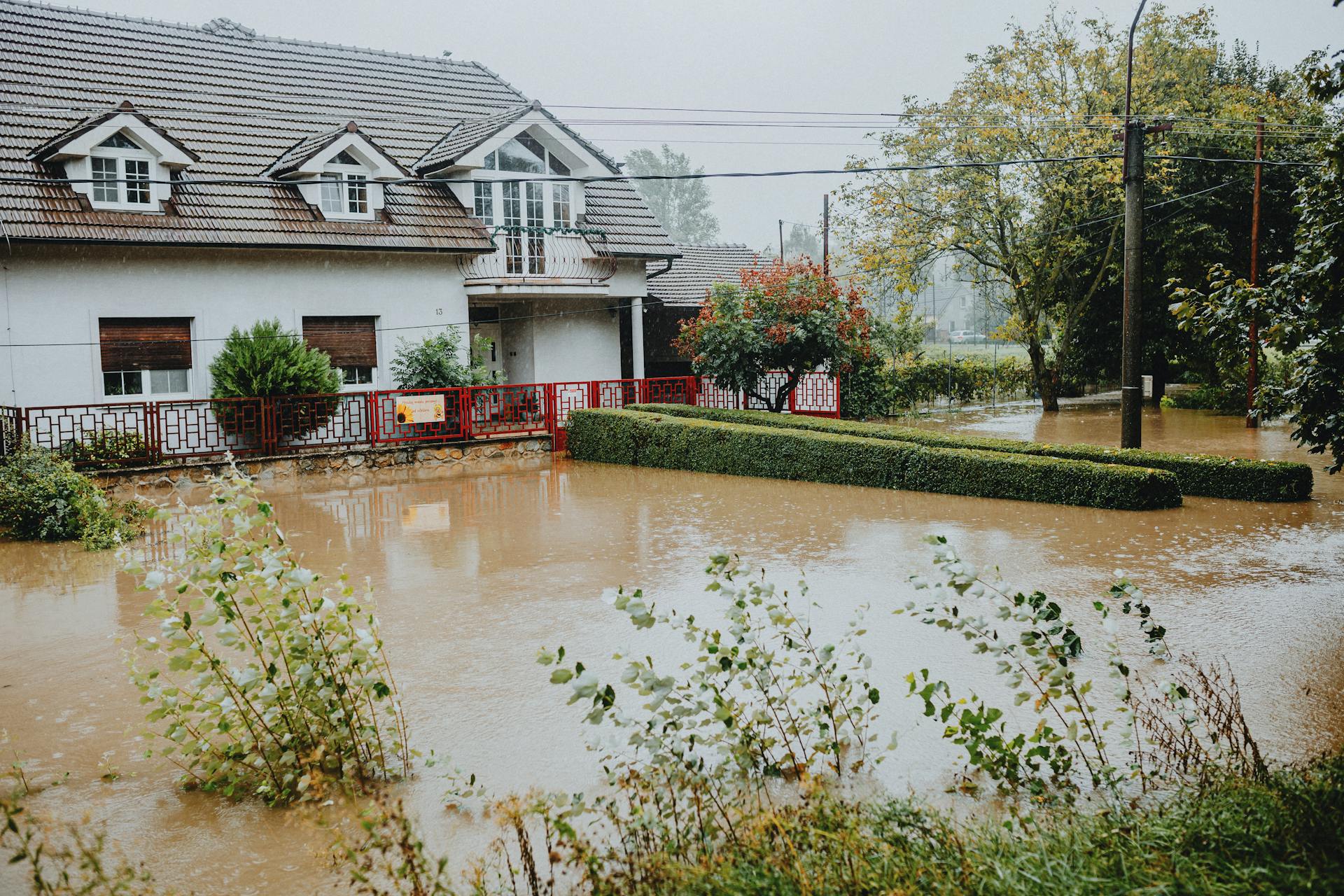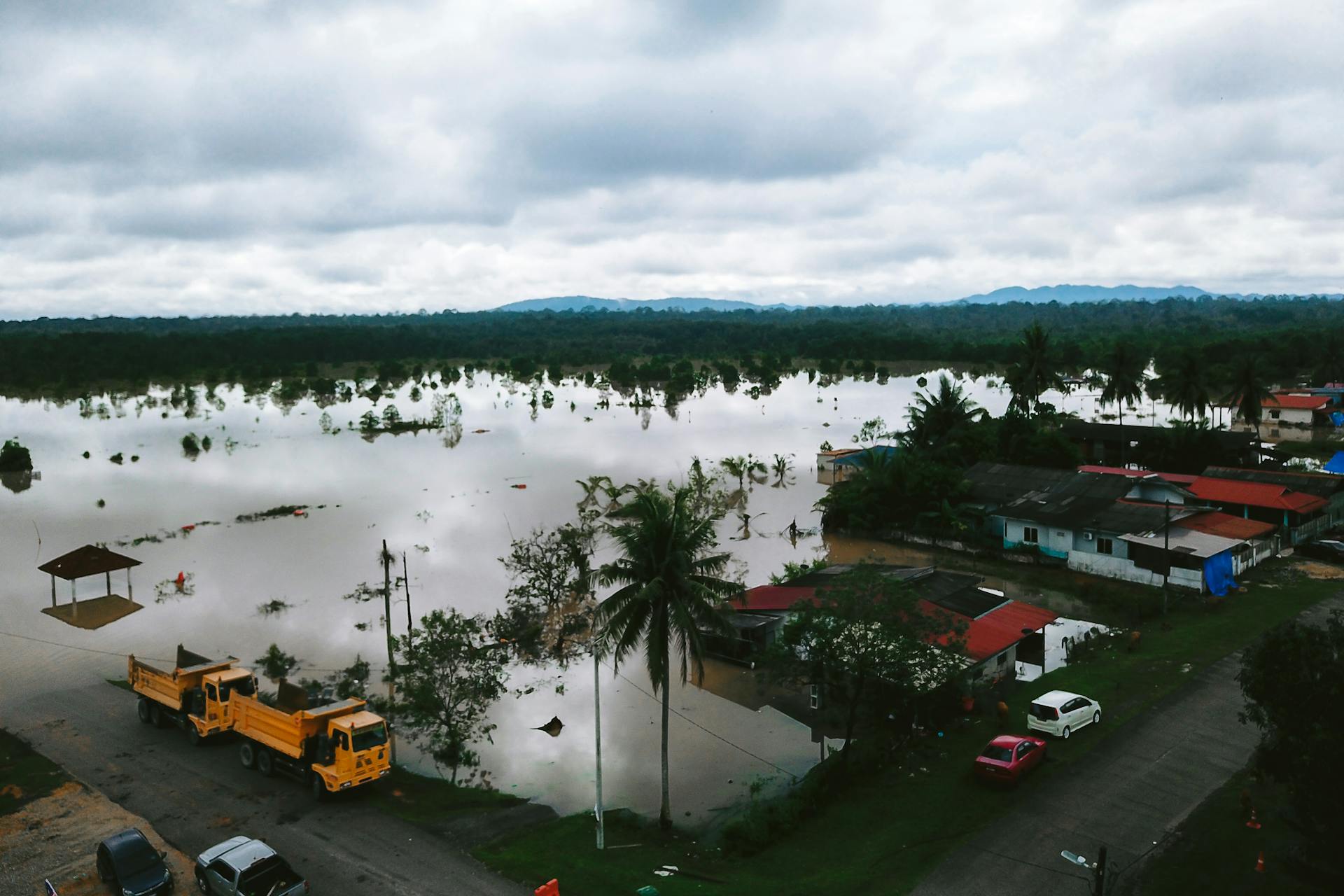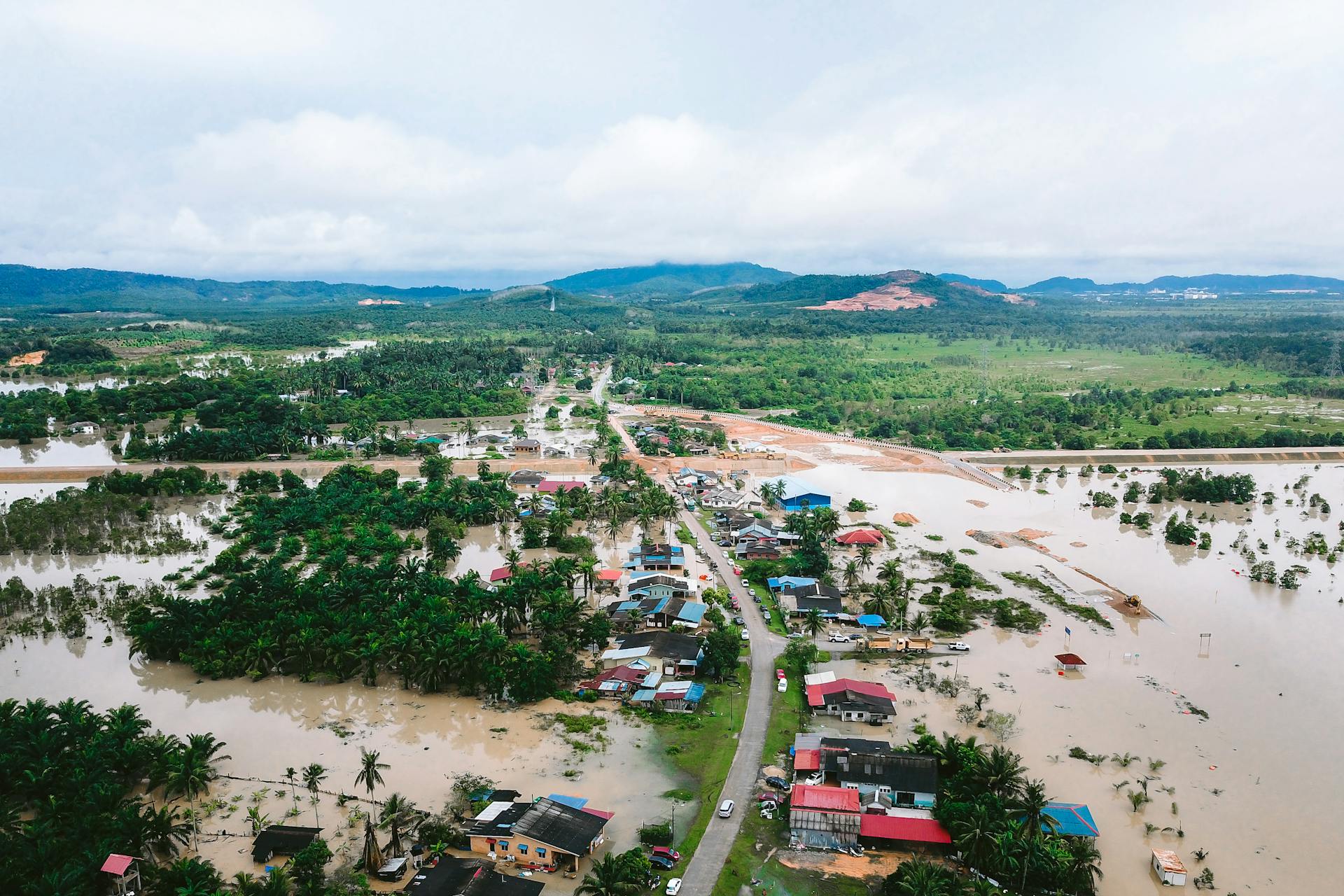
Flood insurance in Texas is a vital protection for homeowners and renters in flood-prone areas. The National Flood Insurance Program (NFIP) is the primary provider of flood insurance in the state.
Flooding can occur from a variety of sources, including heavy rainfall, storm surges, and overflowing rivers. In Texas, the Gulf Coast and Houston area are particularly susceptible to flooding due to their proximity to the Gulf of Mexico.
Flood insurance typically covers damage to a home or building, including the structure and its contents. This can include damage from rising water, storm surges, and overflow from nearby waterways.
Intriguing read: Does Flood Insurance Cover Flooding from Rain
What Flood Insurance Covers
Flood insurance covers a wide range of damages to your home and personal property. In Texas, flood insurance can help cover the cost of repairing or replacing your home structure and belongings.
Flood insurance policies typically cover damage to the building itself, including electrical and plumbing systems, furnaces and water heaters, appliances, and more. This can include items like permanently installed carpeting, cabinets, and bookcases, as well as windows, foundation walls, and staircases.
Flood insurance also covers personal items, such as clothing, furniture, electronic equipment, and artwork. With an NFIP policy, you can usually purchase up to $100,000 in contents coverage.
Here are some examples of what flood insurance typically covers:
- Electrical and plumbing systems
- Furnaces and water heaters
- Appliances
- Permanently installed carpeting
- Permanently installed cabinets, paneling, and bookcases
- Windows
- Foundation walls, staircases, and anchorage systems
- Clothing
- Furniture
- Electronic equipment
- Artwork
It's essential to note that flood insurance does not cover damages to swimming pools, decks, patios, landscaping, cash, paperwork, or basement items. Vehicle flooding coverage is also not included in a flood insurance policy.
Purchasing and Requirements
Purchasing flood insurance is relatively easy, as there are no special requirements. You can simply call the NFIP hotline at 877-336-2627 or reach out to your home insurance agent.
The NFIP has a 30-day waiting period for its policies to take effect, while most private insurance companies in Texas have at least a 10-day waiting period. Call your provider to confirm.
Under federal law, lenders must make you get flood insurance for a mortgage in any high-risk area, or any zone beginning with A or V. This law applies to all federally regulated lending institutions, including banks, nonbanks, and credit unions.
How to Purchase

Purchasing flood insurance is a relatively straightforward process. You can start by calling the NFIP hotline at 877-336-2627.
To get a flood insurance policy, you can also reach out to your home insurance agent. They can guide you through the process and help you find the right policy for your needs.
The NFIP has a 30-day waiting period for its policies to take effect. This is something to keep in mind when purchasing a policy.
Most private insurance companies in Texas have a 10-day waiting period, which is shorter than the NFIP's 30-day waiting period. It's a good idea to call your provider to confirm their waiting period.
You might like: Does an Umbrella Policy Cover Auto Accidents
Requirements
If you live in a high-risk flood zone in Texas, government-backed mortgages and lenders will require you to purchase flood insurance. This is a mandatory requirement to get a mortgage in any high-risk area, or any zone beginning with A or V.
Lenders must make you get flood insurance for a mortgage in these areas, and the law applies to all federally regulated lending institutions, including banks, nonbanks and credit unions. This means you can't get a mortgage without flood insurance in these zones.
The Texas Windstorm Insurance Association (TWIA) has additional flood insurance requirements for homes in high-risk flood zones. If the home was built or altered after Sept. 1, 2009, you need flood insurance to get TWIA windstorm insurance, regardless of your mortgage status.
Recommended read: Auto Insurance Risk Selection
Cost and Rates
The cost of flood insurance in Texas can vary significantly depending on your location and flood risk. The average cost of flood insurance in Texas is $678 per year, but this can be higher or lower depending on the history of flooding events in your area.
If you live in a high-risk flood zone, you can expect to pay more for flood insurance. Homeowners in high-risk flood zones pay 52% more for NFIP flood insurance than those in moderate- and low-risk areas.
The cost of flood insurance also depends on the type of property and coverage amount. NFIP flood insurance premiums are standardized and based on risk zones, while private insurance companies may offer competitive rates based on their underwriting criteria.
Here are some average annual rates for flood insurance in Texas by flood zone:
To find your home's flood risk, you can look it up online at the Flood Map Service Center on FEMA's website.
Companies and Policies
If you're looking for flood insurance in Texas, you have several options. You can buy a policy from the National Flood Insurance Program (NFIP) or from private insurance companies.
Some of the private insurance companies that offer flood insurance in Texas include Neptune Flood, Aon Private Flood, and Hiscox - FloodPlus. You can also consider FloodSimple Insurance Services, Chubb, Zurich Insurance Group, Berkshire Hathaway, Private Market Flood, and TypTap.
If you prefer to buy from the NFIP, you can check out the list of NFIP-participating insurance providers in Texas, which includes companies like Allied Trust, Allstate Insurance Company, and American Nat. Prop. & Casualty.
Here are some of the NFIP-participating insurance providers in Texas:
<
Companies That Offer
If you're looking for companies that offer flood insurance in Texas, you have several options to consider. The National Flood Insurance Program (NFIP) is a great place to start, but you can also get flood insurance policies from private insurance companies.

Many people buy flood insurance policies from the NFIP, but you can also get them from private insurance companies like Neptune Flood, Aon Private Flood, and Hiscox - FloodPlus.
One of the benefits of private flood insurance companies is that they often have a base policy and an excess policy, which can provide supplemental coverage for a base policy. This can be ideal for households that find the NFIP coverage lacking or those that aren't in an NFIP community.
Some popular private flood insurance companies in Texas include Neptune Flood, Aon Private Flood, Hiscox - FloodPlus, FloodSimple Insurance Services, and Chubb. You can also consider companies like Zurich Insurance Group, Berkshire Hathaway, and Private Market Flood.
If you're looking for a more traditional insurance company, you can also consider companies that partner with the NFIP, such as Allied Trust, Allstate Insurance Company, and American Nat. Prop. & Casualty.
Here are some of the companies that offer flood insurance in Texas, grouped by their type of coverage:
Keep in mind that this is not an exhaustive list, and there may be other companies that offer flood insurance in Texas.
Private Policies

Private Policies offer more protection than NFIP policies, which is why many people choose them. They often have higher coverage limits, such as up to $1.5 million in building coverage, compared to the NFIP's $250,000 limit.
Private policies can be tailored to your specific needs and circumstances, providing additional coverage options beyond what NFIP policies offer. For example, they may cover loss of use, or temporary living expenses during flood repairs, which NFIP policies do not cover.
Some private flood insurers have shorter waiting periods for non-loan closings, such as seven days, compared to the NFIP's 30-day waiting period.
Private policies can be obtained through various private insurance companies, rather than the federal government. In Texas, some well-known companies that offer private flood insurance quotes include Allstate, Geico, Neptune Flood, Travelers, and Wright Flood.
Here's a comparison of private policies and NFIP policies:
Keep in mind that private policies can be more expensive than NFIP policies, but they often provide more comprehensive coverage.
See what others are reading: What Auto Insurance Companies Offer 12 Month Policies
Understanding Flood Insurance
Flood insurance can provide up to $250,000 in building coverage, which is essential for repairing and replacing your home structure.
You can usually purchase up to $250,000 worth of building coverage with an NFIP policy, and this coverage is available for single-family homes, townhomes, and condo units.
The deductibles for building and contents coverage range from $1,000 to $10,000.
Here's a quick rundown of what you can expect from NFIP flood insurance in Texas:
NFIP
NFIP flood insurance is a great option for many Texans, but it's essential to understand what it covers. NFIP flood insurance provides up to $250,000 in building coverage and up to $100,000 in contents coverage.
The building coverage pays to repair structural damage to your home, and it's available for single-family homes, townhomes, and condo units. Contents coverage insures your belongings, and if you rent, you can buy contents-only flood insurance.
Deductibles for both coverages range from $1,000 to $10,000. This means you'll need to pay a portion of the repair costs out of pocket before your insurance kicks in.
For your interest: Endurance Auto Repair Insurance
If you get flood insurance to satisfy a mortgage requirement, an NFIP policy can take effect on your close date. Otherwise, you have to wait 30 days for your coverage to start.
Texas flood insurance rates vary depending on your location. Homeowners in high-risk flood zones pay 52% more for NFIP flood insurance than those in moderate- and low-risk areas.
Here's a breakdown of the annual and monthly rates for different flood zones in Texas:
Keep in mind that high-risk flood zones are designated by FEMA's flood maps, and any flood zone code that begins with the letter A or V is considered high risk. If you're unsure of your home's flood risk, you can look it up online at the Flood Map Service Center on FEMA's website.
Here's an interesting read: Does Builders Risk Insurance Cover Theft
Risk Rating 2.0
FEMA's Risk Rating 2.0 system was implemented in October 2021, which bases rates on individual property risks.
This new system incorporates variables like your home's elevation, physical structure, and rebuilding costs to determine flood risk.
Risk Rating 2.0 promises fairer and more accurate premiums for flood insurance.
However, your location will still heavily impact the final rate you'll get.
Purchasing more coverage raises your premium, so it's essential to consider your needs carefully.
The type of coverage you get can also influence your rates, and options may vary depending on your state and county.
A higher deductible can lower your monthly premium, but keep in mind that you'll need to pay more out-of-pocket when filing a claim.
Deductibles typically range from $1,000 to $10,000.
The age of your home is also taken into account when determining rates, and you can expect a higher premium if your home is relatively old.
Your home's design and construction materials are also considered when calculating rates.
Readers also liked: When Will Insurance Cover Weight Loss Drugs
Sources
- https://www.raiznerlaw.com/blog/what-does-flood-insurance-cover-in-texas/
- https://www.moneygeek.com/insurance/flood/texas-flood-insurance-costs/
- https://www.geico.com/information/aboutinsurance/flood/
- https://www.lendingtree.com/home-insurance/texas-flood-insurance/
- https://albtriallawyers.com/legal-jargon-decoded-understanding-your-flood-insurance-policy/
Featured Images: pexels.com


